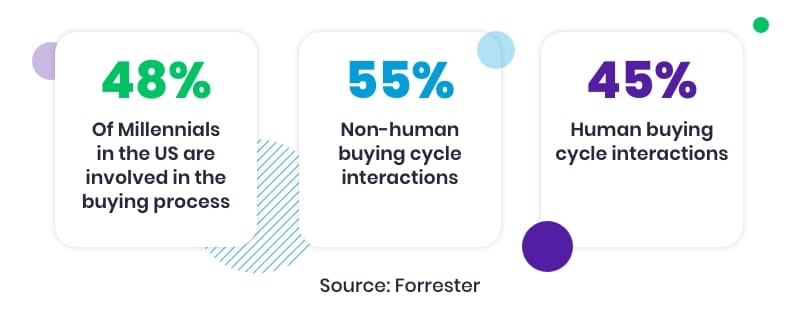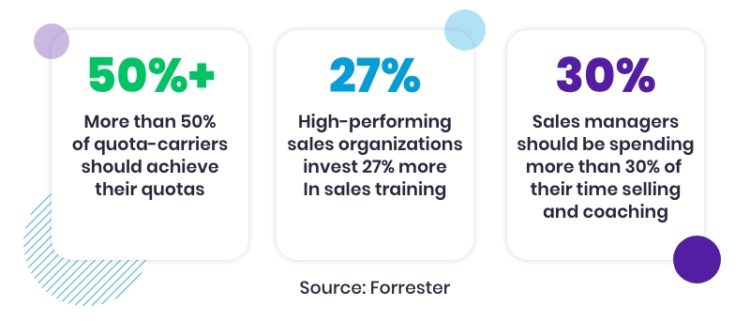Each December, we ask industry analyst Forrester Research to help us identify the top B2B sales trends for the year ahead. The information is always insightful and motivating. But in the most challenging selling environment ever, this year’s list carries even more weight.
5 B2B Sales Trends Sales Leaders Need to Embrace in 2022
I think most of us are hoping 2022 will be…different. After a tumultuous 20+ months plagued by staffing shortages, budget cuts, production and shipping delays, sales leaders, in particular, are looking to start the new year off right. To help, we asked Rick Bradberry, Principal Analyst at Forrester, to join our most recent webinar to discuss what B2B sales trends sales leaders should embrace this year to engage customers and increase predictable revenue growth.
Here are the trends he highlighted in the session and how to address them:
1.B2B buying behavior has shifted
B2B buying demographics have changed. And today’s increasingly digital buyers have higher expectations than previous generations. To make a confident purchase decision, they need sellers to:
- Be transparent and make information readily available
- Help them navigate the buyer journey
- Offer digital-first options and personalized sales interactions
- Make the buying process as painless (and ideally, self-service) as possible

Today’s buyers come to the table with both money and information. But it’s up to the sales rep to help them make sense of that information. While the buyer may be in the driver’s seat, the seller should serve as their GPS throughout the buying process, successfully steering them towards a purchase decision.
Fortunately, digital-first buyers mean a wealth of data available to help sellers shape interactions. Use buying signals from buyer intent, conversation intelligence, sales activity, and content engagement data to identify what matters most to your buyer and inform and personalize the content you send, presentations you give, and conversations you have.
With buyers interacting in more channels than ever before, understanding their behavior at every touchpoint is critical to identifying the next best sales action and determining the likelihood that a deal will close.
2.B2B sales teams are adopting new operating models
Right now, it’s challenging to hire and retain sales talent. Sales turnover is at an all-time high. But, if you can create a buyer-centric operating model including the right insights, infrastructure, and processes, you can add more value for sales reps, increase productivity, and drive sales success. Successful sellers are typically happy sellers.

Focus on how your buyer wants to purchase and orchestrate your business processes around that. Invest more energy and resources in sales coaching and development for a high-performing sales organization. If you equip your sellers to have the insights-driven and value-led conversations buyers want, they should achieve their quotas, make more money, and as a result, stay put.
The role of the sales leader has broadened. You can’t just hold sellers accountable to numbers. You also need to cultivate your sales talent to help them achieve those numbers.
3.Technology is transforming B2B sales
Digital-first buyers make digital sales transformation a necessity.

Today’s AI-empowered sales tech tools change the game for sales reps. Sales enablement and revenue intelligence solutions capture critical buyer engagement data that sellers can leverage to determine where to focus their efforts, how to best engage, and who within a buying team has the ultimate decision-making power.
The more behavioral data you can capture, the more value you can add for buyers. Adopt an insights-driven sales system to follow buyers everywhere they engage on their journey, aggregate and analyze the signals they’re giving, and allow machine learning to prescribe the next best sales action. Doing so empowers sellers to offer buyers contextualized and personalized content at the right time. As a result, your sales reps can improve buyer engagement, accelerate sales cycles, and win more deals.
These solutions also aggregate and analyze sales activity data to help sales leaders improve and streamline internal processes including hiring, onboarding, training, forecasting, etc.
4.The revenue engine is changing
From demand generation to channel sales to e-commerce purchases to customer success, there are many components in your revenue engine.
As a leader, it is critical to ensure all these groups are aligned and collaborate effectively to produce results for the organization at large.

Adopt a revenue operations model to align your teams with a consolidated tech stack and business processes to hold everyone accountable to a common goal (revenue) and watch performance improve by default.
To be successful in 2022, you have to rethink the structure of your organization. Your sellers, marketers, and customer success or account management groups should not operate in silos. They are all a part of your revenue team but with different areas of specialization that meet your buyer’s needs at varying points in the buyer journey.
5.The future of B2B sales is a bolder frontier
The sales landscape is changing. Your sales strategy needs to change along with it. Put customers at the center of everything you do, and follow the 5 P’s of sales to ensure your sellers can be successful in a challenging sales environment.
In 2022, your sales strategy should prioritize:
- Precision – Leverage AI-empowered tools, data, and insights to make it easier for sales reps to sell to buyers.
- Personalization – Modern buyers expect a personalized buying experience.
- Productivity – Take reps out of low-value meetings and activities, so they can spend more time with customers.
- Profitability – Don’t just look at your top-line bookings number. Look at the composition of your bookings including profit margins, total contract value, etc.
- Purpose – Buyers want to know they are doing business with organizations that make a difference in the greater community. Your customer-facing teams should be prepared to communicate your social purpose.
Use B2B Sales Trends to Shape Your Sales Strategy in 2022
If you take anything from these trends, it’s this: 2022 is all about the customer. Your buyers have changed (again), and you need to adapt your sales practices to accommodate those changes. If you can deploy the tools and strategies to align your revenue teams and help them sell the way your buyers want to buy, you will position your sellers and organization for great success in the year ahead.
Are you struggling to forecast and hit revenue targets? View our latest on-demand webinar featuring Mary Shea, former Forrester Analyst and VP Global Innovation at Outreach for more expert advice.

Comments are closed.